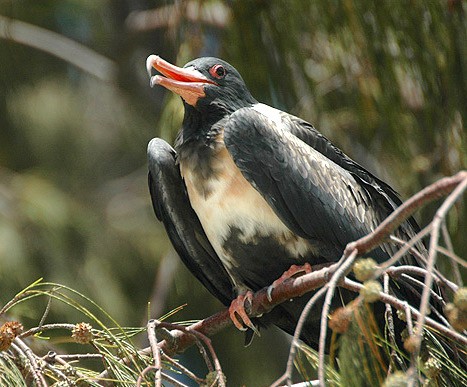Lesser Frigatebird
A species of Frigatebirds Scientific name : Fregata ariel Genus : Frigatebirds
Lesser Frigatebird, A species of Frigatebirds
Botanical name: Fregata ariel
Genus: Frigatebirds
Content
Description General Info
Description
The lesser frigatebird is the smallest species of frigatebird and measures 66–81 cm (26–32 in) in length with a wingspan of 155–193 cm (61–76 in) and long forked tails. Male birds weight 625–875 g (1.378–1.929 lb). Female birds are heavier and weight 760–955 grams (1.676–2.105 lb). Like all frigatebirds the male has a large red sac on the front of the throat which is inflated during courtship. Courtship display also involves a variety of calls, bill rattling and spreading of the wings. The male is mostly all black save for a white patch on the flank which extends on to the underwing as a spur. Males also have a pale bar on the upper wing. Females have a black head and neck with a white collar and breast as well as a spur extending on to the underwing. The female also has a narrow red ring around the eye. Juveniles and immature birds are more difficult to differentiate but the presence of the spurs of white in the armpits is a helpful distinguishing sign. Frigate birds are built for flying; they rarely swim and cannot walk but can manage to climb around the trees and bushes in which they nest. They have a very light skeleton and long narrow wings and are masters of the air. Their name probably derives from the fact that they harass other sea birds such as boobies and tropicbirds as they return to their nests from feeding, forcing them to disgorge their catch, which is then swooped upon and caught by the frigate birds before it reaches the water below. This practice seems to be more common among female frigate birds, but probably only accounts for a fairly small proportion of the diet, which mainly consists of squid and flying fish scooped up from the surface of the sea. 
Size
75 cm (29.5 in)
Life Expectancy
17-28 years
Nest Placement
Tree
Feeding Habits
Lesser Frigatebird predominantly feeds on fish, flying fish, and squid. Lesser Frigatebird exhibits kleptoparasitism, stealing prey from other seabirds. Lesser Frigatebird also consumes seabird eggs, chicks, and carrion. Unique adaptations include aerial agility to snatch fish scraps from the ocean's surface.
Habitat
Lesser Frigatebird predominantly resides in tropical and subtropical seas, utilizing small and remote islands as their breeding grounds. These islands often feature vegetation such as mangroves, bushes, and scrub, including Pemphis, Lepturus, and Tournefortia species. Lesser Frigatebird exhibits a flexibility in nesting habits, ranging from lower vegetation to ground nesting in some regions. It forages in the adjacent ocean waters, generally where temperatures exceed 22°C within the pelagic zone.
Dite type
Scavenger
General Info
Feeding Habits
Bird food type
Distribution Area
The lesser frigatebird is said to be the most common and widespread frigatebird in Australian seas (Lindsey, 1986). It is common in tropical seas, breeding on remote islands, including Christmas Island in the Indian Ocean in recent years. These birds are most likely to be seen from the mainland prior to the onset of a tropical cyclone, and once this abates they disappear again. 
Species Status
Not globally threatened.
Scientific Classification
Phylum
Chordates Class
Birds Order
Gannets and Relatives Family
Frigatebirds Genus
Frigatebirds Species
Lesser Frigatebird 